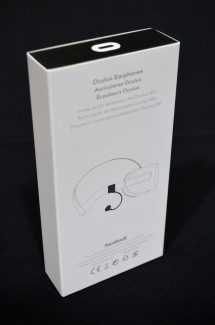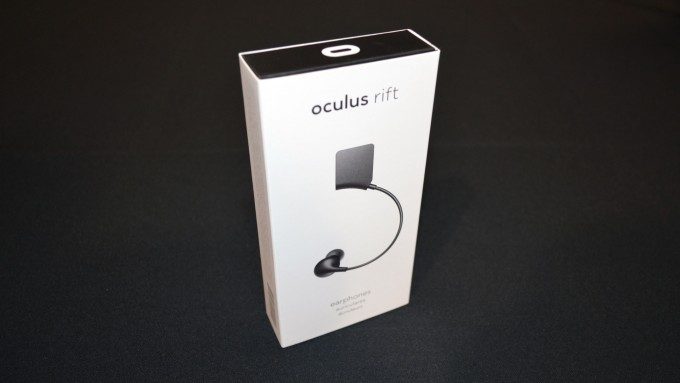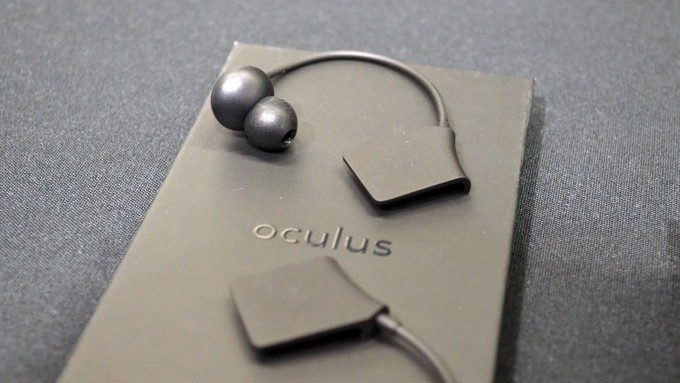In-depth
Frequency Response
Lacking the equipment to do a measurement of the sonic characteristics, I’ve instead noted details on the frequency response by listening to sine sweeps. (No idea what frequency response is? Check out this primer).
The original headphones have a very similar curve, but seem to be a little less smooth over the entirety, especially in the region from 3-12 kHz, where a small dip happens at 4 kHz, which then turns into a peak at 5.3 kHz. Usually, such a resonance in that frequency range above 5 kHz can lead to a relatively more “artificial” or “metallic” sound. However, it was a very small difference, and was hard to notice in normal use.
In my tests with VR applications, I could certainly hear the difference between the Earphones and the standard Rift headphones. In the Oculus Dreamdeck experience for example, the dinosaur at the end roared with incredible rumble, but also with a very coarse air coming out of her throat that was much sharper. In addition, the positions of these sounds were more apparent and separable from each other, as I could more clearly tell the air in dinosaur’s throat apart from the roar.
Something else I tried was closing my eyes, and just following the sound with my ears. On the standard headphones, I found that the sound from the dinosaur was harder to pinpoint as the breathing was more ambiguous and “smeared” across the left and right channels, meaning that the “imaging” characteristic was somewhat worse. Though the complete explanation is more complicated, these results make sense because humans sense the locations of sounds mostly through high frequencies, which these IEMs have improved on.
On the last characteristic I’ll talk about, I found that the “soundstage”, or the ability to render sounds at distances is better than the standard headphones. The Earphones sounded a lot more natural to my ears in how they represented sound at equal distances. Before, for example, when you were looking directly at the fireplace in Oculus Home, the flames would sound more faint and distant, and when you turned to let it face your right or left ear, it would sound a lot closer. That wasn’t a problem on the Earphones.
Not only that, but they were also able to present nearer sounds more accurately. In the miniature town part Oculus Dreamdeck, I could get so close to the paper airplane flying around that it felt like it should have been touching my head, while with the standard headphones, it was as if the sound source was just a bit shy of wanting to touch me, preferring to stay somewhat distant. Much of these differences actually have to do with the inherent properties of IEMs compared to headphones, but that’s beyond the scope of this review.
Noise-isolation
While I’ve harped on about sound quality, actually the more important thing I’ve noticed is that the Earphones block sound enough to let you clearly hear the subtle ambient noises present in many VR applications without distraction. If you have a humming PC or the sound of cars outside your apartment while doing VR, the real ambience can, without you consciously knowing it, distract from the feeling of actually being in the virtual world.
I found that while using the Earphones, it was much easier to forget where I was in real life, and I could really hear subtle sounds I wasn’t easily able to before, like the echos of my footsteps while trekking through caves in FATED: The Silent Oath. This feature alone already makes these IEMs worth getting if you’re someone like me, who lives in a bustling house with other people.
Effect of Tip Selection
I found that the difference in sound between the packaged tips was imperceivable, while tips from different brands had a big impact. The Comply foam tips, while they were more comfortable and blocked more outside noise, somewhat muffled high frequencies. The Spinfit eartips made things sound a bit “tinny” or “artificial”. The Meelectronics actually didn’t change the sound too much. In the end, I still preferred the tips that shipped with the Earphones.
Comparison to Ultra High-end ($1,300) IEMs
When the Oculus Earphones were announced, the company claimed they compared favorably to $900 pair of IEMs. While they didn’t specify exactly which, I’m fortunate to have a pair of JH Audio Roxanne Universals handy for comparison. These IEMs retailed for $1,300 and were critically acclaimed for having superb clarity and transparency in vocal detailing. In other words, they had really good midrange sound, and I’ve confirmed all of this from my own testing.
 However, even if the Roxannes perform well for what they were designed for (vocals), they don’t fit certain other tastes of music or use cases as well. It could be said that the technical capabilities of the Roxannes are beyond those of the Oculus Earphones, but the their tuning doesn’t work with VR as well. For VR, the frequency response should follow a balanced curve so that things are as accurate as to what you would hear in real life, and the Oculus Earphones achieve this. A balanced frequency response has a huge impact on almost all characteristics of sound perception, so it can not be underestimated. That’s why I’ve concluded that these Earphones sound (mostly) better than the Roxannes for use with VR.
However, even if the Roxannes perform well for what they were designed for (vocals), they don’t fit certain other tastes of music or use cases as well. It could be said that the technical capabilities of the Roxannes are beyond those of the Oculus Earphones, but the their tuning doesn’t work with VR as well. For VR, the frequency response should follow a balanced curve so that things are as accurate as to what you would hear in real life, and the Oculus Earphones achieve this. A balanced frequency response has a huge impact on almost all characteristics of sound perception, so it can not be underestimated. That’s why I’ve concluded that these Earphones sound (mostly) better than the Roxannes for use with VR.
In almost all instances when dealing with audio that wasn’t mainly vocals, the Oculus Earphones represented sound with more accurate tonality, clarity, and spatial positioning. When I was listening to Let it Rain by Amanda Marshall, the Roxannes sounded slightly more congested and closed in with regards to the instrumental track, but truly did output the vocals with a feeling of tactility that was not present on the Oculus Earphones.
When I examined the Roxannes’ frequency response with sine waves, I could perceive a very smooth curve across the whole range with really only one big peak at around 6-8 kHz that rose gently. On the other hand, the Oculus Earphones had a more bumpy and wild curve. They also had a bit of harmonic distortion, which wasn’t present on the Roxannes, though it was only noticeable with close listening of sine sweeps. Despite that, Oculus Earphones still sounded better for the majority of my time using them, and definitely had the upper hand when used for VR.
Oculus probably pushed their transducers as far as they could with the budget they had, and the result is something that’s technically imperfect, but impressive in practical usage. So yes, to those who were skeptical of Oculus’ claims, it would seem to me that the Earphones can in fact compare favorably to $900 or more IEMs, even if not in every aspect necessarily. But speaking honestly, this doesn’t come as a surprise to me. It’s generally observed in the headphones industry that the more you pay, the less you get back in value per dollar. And with technology constantly improving, the returns keep diminishing, so it makes sense that this special case of IEM is partly able to compete at a much higher price point. Nevertheless, it is highly commendable that Oculus has achieved this level of proficiency.
Disclosure: Oculus gave all attendees of their Connect developer conference, including this reviewer, a pair of Earphones.









